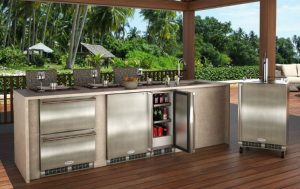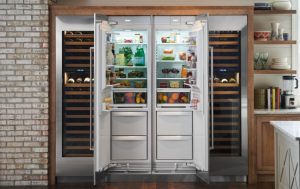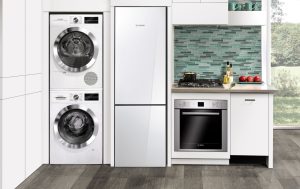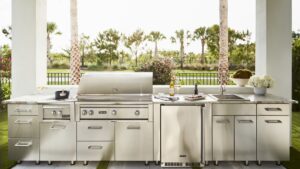Your Guide to the Different Types of Ovens
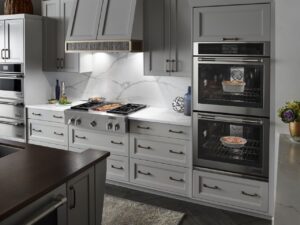
The oven is often the center of your kitchen. It is a hardworking appliance that you rely on to make favorite meals, heat prepackaged food and even bake breads or cakes. So, it is crucial that you choose the right oven for your kitchen when you’re shopping for a new appliance. There are several things to consider and you need to understand the capabilities, configurations and features of each type of oven to make your purchase decision. So, in this guide we’ll help you to discover the different types of ovens and how to know which one is right for your home.
Oven Configurations:
When you’re shopping for a new oven, one of the first things you will need to appreciate is that ovens are available in a variety of configurations. These can be roughly divided into two categories so, you should think about which one will fit best in your home.
The Range Oven:
Ranges offer a combination of cooktop and oven, which is ideal if you have a smaller kitchen that lacks tha space for two separate appliances. It can also be a good way to make your oven a feature in your kitchen design, as it can take center stage.
There are several types of ranges:
- Freestanding: A freestanding range features a built in backsplash. This typically houses some of the controls and the main display panel.
- Slide In: Slide in ranges are designed as a built in appliance to create a seamless look to your kitchen. The range can be incorporated into your cabinetry for clean lines. This also prevents crumbs and cooking debris from falling between the appliance and its surrounding cabinets.
- Double Oven: Double oven ranges tend to be larger appliances as they feature two separate ovens. This is a great option for serious home cooks as you can simultaneously prepare multiple dishes even if they require different cooking temperatures.
The Wall Oven:
Wall ovens can be directly installed into your cabinets or wall. This frees up floor space and can create a more premium look to your kitchen aesthetic. They do not include a cooktop, so you will need to install your cooktop separately.
You can find wall ovens in both single or double configurations. Single wall ovens tend to be more versatile as they have a smaller size, so they can be installed in a cabinet, underneath a countertop or in a wall.
Double ovens provide an additional oven cavity. Typically, both oven spaces are the same size, for double cooking space, but some models do have a smaller and a larger oven to save space. These are a great option if you like to create large meals that require different cooking times, settings and temperatures.
Fuel Types:
Once you’ve decided on the best configuration of the oven, you will need to consider the fuel type. The main fuel types for ovens are gas and electric. Many kitchens will already be equipped for an electric appliance installation, but you may need to have a dedicated gas line installed if you prefer a gas oven.
Electric ranges have electric coil burners, while gas ranges have gas burners on the stovetop, but there are some range models that are dual fuel. This means that they have gas burners and an electric oven.
Electric is the most common fuel type for ovens. It offers consistent, even heating that is powered either using a standard 120 v outlet or a 240 v circuit. Which one depends on the specific electric oven model.
Electric ovens are a good option if you like to bake pastries as the heat is typically more consistent throughout the entire baking process.
Gas ovens are preferred by cooks who like to bake and keep their roasts juicy. Gas offers faster cooking times and you can preheat the oven slightly faster compared to an electric model. Typically, you cannot find gas wall ovens. If you are thinking about a built in wall oven, you will need to choose between this configuration and having a gas oven.
Some gas oven models feature some innovative features like Scan to Cook, which uses the barcode on frozen food packaging to automatically select the proper temperature and cook time. You can also find Frozen Bake Technology that allows you to skip preheating and enjoy a faster cook time on your frozen favorites.
Heating Style:
When you’re considering a new oven, you will also need to think about the heating style. There are conventional and convection style ovens that are both available as wall ovens or ranges.
Convection:
Convection technology uses a fan and exhaust system which circulates the hot air throughout the oven cavity. This helps to keep the temperatures even on the different racks. This is a good choice if you tend to use multiple racks when cooking so you can minimize needing to rotate dishes between the racks. It can also promote crisping and browning when you’re roasting. Additionally, the circulated air can reduce the cooking time to prevent over dried dishes.
Conventional:
As the name suggests, conventional ovens are the most typical heating style. It does not have a fan to circulate the heated air, but rather uses a traditional electric or gas heating element to generate the heat.
This type of heating style offers familiar functionality, but you can achieve different cooking results according to where you place the baking dish on the oven racks. This can provide a still environment that is preferable for delicate cake recipes.
Specialized Features:
Another important consideration is whether your new oven has the right features to suit your cooking preferences and help you to spend less time cooking. Some examples of these features include:
Smart Technology:
Smart ovens can help you to cut down on the cooking time, as you can monitor and control the oven using your smartphone or voice commands. Many models allow remote control of bake and temperature settings. So, you can keep an eye on your dishes while you’re ticking off your other chores around the house.
Self Cleaning Features:
A self cleaning oven has a setting that makes after cooking clean up easier. This feature uses either low or high heat that loosens baked on food debris and spills. You can then wipe any remnants for a sparkling clean oven.
Traditional self cleaning models use higher temperatures that will burn any food debris to a powder that you can easily wipe away. On the other hand, some models use steam cleaning, which involves water to soften and loosen food particles that can then be easily wiped away.
Air Fryer Capabilities:
If you have limited counter space or simply prefer to have a single appliance that can handle many jobs, you should look for an oven with air fryer capabilities. Air fryers have become a massive trend, allowing you to enjoy faster cooking times and fryer like results without the need for excessive amounts of oil. Air frying helps to create crisp cooking results by circulating hot air around the food. This creates a fried texture without the need for the messy clean up associated with a deep fryer.
FAQs:
When you are shopping for a new oven, you’re likely to have lots of questions that you will need answered before you can make your purchase decision. So, here we’ve compiled answers to some frequently asked questions to make your shopping a little easier.
What’s a Dutch Oven?
Throughout this article, we’ve not mentioned Dutch ovens in terms of configuration or oven style as it is not actually an oven. A Dutch oven is actually a cooking pot that has a right fitting lid. This can be used in the oven or on your stovetop. Typically made of cast iron, this is a durable piece of cookware that is great for slow cooking a casserole or stew. The cast iron reduces the risks of food sticking, but the tight fitting lid contains the heat for even cooking results.
You can also use dutch ovens to bake breads and make other types of delicious dishes.
Which Oven is Best for Cakes?
If you frequently bake cakes, an electric oven is likely to be a better choice for you rather than a gas fueled model. The electric heating element frequently switches on and off to maintain a consistent cooking temperature.
Which Type of Oven is Best for a Contemporary Kitchen?
This will depend on your overall kitchen aesthetic. If you want clean lines, a built in oven will blend in with your cabinetry. On the other hand, if you want to make your oven a feature in your kitchen design, a freestanding range can work well. There are freestanding ranges in both traditional and contemporary styles, making it easy to find one to suit your preferences.
These days, there are plenty of oven models on the market with a wealth of features and functions. There is no one size fits all solution for the best oven model as you will need to think about your cooking preferences, kitchen layout and the features you consider important.
If you’re considering a new oven, you can explore your options with this online collection or speak to one of our home appliance experts for additional help and guidance.
- Designing the Ultimate Outdoor Bar: Must-Have Appliances for Year-Round Fun
- Luxury Refrigerator Guide 2025: Built-In vs. Freestanding and What to Know Before You Buy
- How Smart Appliances Are Changing Luxury Kitchen Design in 2025
- The Ultimate Outdoor Grill Guide for 2025: Built-In vs. Freestanding
- Smart Bathroom Faucets & Fixtures in 2025: Blending Technology with Luxury Design
- Built-In Coffee Machines: Are They Worth It for Your Kitchen in 2025?
- How to Choose the Right Dishwasher for Your Home: Noise, Capacity, and Features Explained
- Top 5 Kitchen Appliance Colors and Finishes for 2025 (And How to Match Your Style)
- Why a Countertop Ice Maker is a Must-Have for Summer Kitchen Upgrades in Southern California
- How to Remove Scratches from Stainless Steel Luxury Appliances


